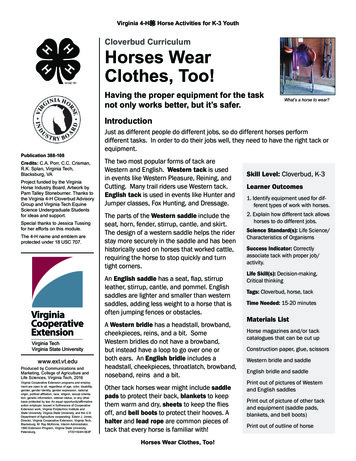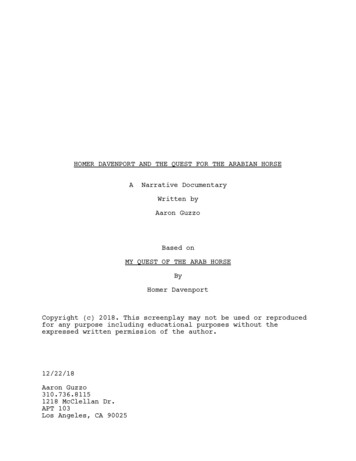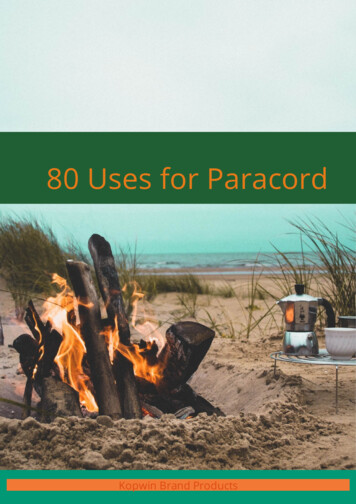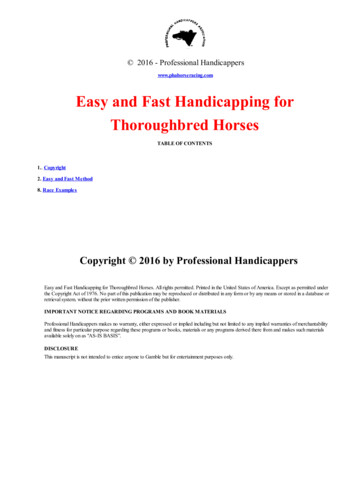
Transcription
Virginia 4-HHorse Activities for K-3 YouthCloverbud CurriculumHorses WearClothes, Too!Having the proper equipment for the tasknot only works better, but it’s safer.What’s a horse to wear?IntroductionPublication 388-108Credits: C.A. Porr, C.C. Crisman,R.K. Splan, Virginia Tech,Blacksburg, VAProject funded by the VirginiaHorse Industry Board. Artwork byPam Talley Stoneburner. Thanks tothe Virginia 4-H Cloverbud AdvisoryGroup and Virginia Tech EquineScience Undergraduate Studentsfor ideas and support.Special thanks to Jessica Tussingfor her efforts on this module.The 4-H name and emblem areprotected under 18 USC 707.Just as different people do different jobs, so do different horses performdifferent tasks. In order to do their jobs well, they need to have the right tack orequipment.The two most popular forms of tack areWestern and English. Western tack is usedin events like Western Pleasure, Reining, andCutting. Many trail riders use Western tack.English tack is used in events like Hunter andJumper classes, Fox Hunting, and Dressage.The parts of the Western saddle include theseat, horn, fender, stirrup, cantle, and skirt.The design of a western saddle helps the riderstay more securely in the saddle and has beenhistorically used on horses that worked cattle,requiring the horse to stop quickly and turntight corners.An English saddle has a seat, flap, stirrupleather, stirrup, cantle, and pommel. Englishsaddles are lighter and smaller than westernsaddles, adding less weight to a horse that isoften jumping fences or obstacles.Produced by Communications andMarketing, College of Agriculture andLife Sciences, Virginia Tech, 2016A Western bridle has a headstall, browband,cheekpieces, reins, and a bit. SomeWestern bridles do not have a browband,but instead have a loop to go over one orboth ears. An English bridle includes aheadstall, cheekpieces, throatlatch, browband,noseband, reins and a bit.Virginia Cooperative Extension programs and employment are open to all, regardless of age, color, disability,gender, gender identity, gender expression, nationalorigin, political affiliation, race, religion, sexual orientation, genetic information, veteran status, or any otherbasis protected by law. An equal opportunity/affirmativeaction employer. Issued in furtherance of CooperativeExtension work, Virginia Polytechnic Institute andState University, Virginia State University, and the U.S.Department of Agriculture cooperating. Edwin J. Jones,Director, Virginia Cooperative Extension, Virginia Tech,Blacksburg; M. Ray McKinnie, Interim Administrator,1890 Extension Program, Virginia State University,Petersburg.VT/0116/4H-563POther tack horses wear might include saddlepads to protect their back, blankets to keepthem warm and dry, sheets to keep the fliesoff, and bell boots to protect their hooves. Ahalter and lead rope are common pieces oftack that every horse is familiar with!www.ext.vt.eduHorses Wear Clothes, Too!Skill Level: Cloverbud, K-3Learner Outcomes1. Identify equipment used for different types of work with horses.2. Explain how different tack allowshorses to do different jobs.Science Standard(s): Life Science/Characteristics of OrganismsSuccess Indicator: Correctlyassociate tack with proper job/activity.Life Skill(s): Decision-making,Critical thinkingTags: Cloverbud, horse, tackTime Needed: 15-20 minutesMaterials ListHorse magazines and/or tackcatalogues that can be cut upConstruction paper, glue, scissorsWestern bridle and saddleEnglish bridle and saddlePrint out of pictures of Westernand English saddlesPrint out of picture of other tackand equipment (saddle pads,blankets, and bell boots)Print out of outline of horse
Virginia 4-HDid You Know?A hackamore is a “bitless” bridle!Glossary WordsBell boots – bell-shaped rubbermaterial designed to protect thecoronary band and hoofCantle – raised rear portion of asaddle (both Western and English)Fender – leather flap that protectsthe rider’s leg from the girth andrigging of a Western saddleFlap – leather piece that protectsthe rider’s leg from the girth on anEnglish saddlePommel – the upper front part of anEnglish saddleSaddle horn – raised front part of aWestern saddle, designed to allow acowboy to tie a rope to when workingcattleSkirt – area at the back of a Westernsaddle, resting over the horse’s backand sides, designed to protect thehorse from equipment hanging fromthe saddleTack – refers to the equipmentplaced on a horse, including saddles,bridles, halters, blankets, and bootsHorse Activities for K-3 YouthExperience / What to DoPart 1: Saddles1. Give each child a picture of a Western and an English saddle.2. Using the real saddles, explain parts of the Western saddle. Asyou point them out, have the children color the appropriate parton their picture.3. Do the same with the English saddle.4. Have the children then explain the differences and similaritiesbetween the two saddles.Part 2: Bridles1. Give each child a picture of a Western and an English bridle.2. Using the real bridles, explain parts of the Western bridle. As youpoint them out, have the children color the appropriate part ontheir picture.3. Do the same with the English bridle.4. Have the children then explain the differences and similaritiesbetween the two bridles.Part 3: Other Tack1. Distribute the horse outline and tack pictures.2. Have the children color the tack and the horse.3. Have the children cut out the tack of their choice and glue it onthe horse outline.4. Let the children then describe what sort of activity the horsewould be doing while wearing that tack.Favorite Jobs1. Using magazines or catalogues that have been brought inor provided, allow children to select pictures of horses doingdifferent activities while wearing tack or equipment.2. Have them cut out their selected pictures and glue them toconstruction paper to make a collage.3. Have each child share with the group what activities their horsesare doing.For More InformationSearch www.extension.org/ for additional information.References“Equine Science – Basic Knowledge for Horse People of All Ages” by Jean T. Griffiths.www.Horsebooksetc.com or Phone: 1-800-952-5813“Horse Science” by Ray Antoniewicz. www.4-hmall.org/detail.aspx?ID 16681“Horses & Horsemanship” by Ray Antoniewicz. www.4-hmall.org/detail.aspx?ID 16680Horses Wear Clothes, Too!
Virginia 4-HHorse Activities for K-3 YouthTalk It OverShare . . .1. What kinds of jobs or activities can horses do? Are all horses involved in the same activities?2. What kind of tack is appropriate for a jumping horse? A western pleasure horse?Reflect . . .1. What makes a horse better suited for one job than another?2. Do people ever change jobs? Do horses? Why or why not?Generalize . . .1. Why is it important for us to have good, safe equipment for the jobs we do?2. How is making a decision about which tack to use important to the job of horses?Apply . . .1. When might you use the skills you learned today?2. How would you teach others the skills you learned today?Horses Wear Clothes, Too!
Virginia 4-HHorse Activities for K-3 YouthMore Ideas!Horses Drive, Too!Equipment used for driving is different than for Western or English riding. An English-style bridle iscommonly used, but with the addition of blinkers or blinders that block the horses view to the sides. Aharness is used to connect the horse to the cart. Some important parts are a collar (to help distribute theweight of the cart when the horse pulls), breeching (a strap behind the haunches to help the horse brakethe cart), traces (help distribute the weight of the cart along the collar), a saddle or pad (lies across thehorse’s back to help distribute weight), girth (to hold the harness to the saddle), a crupper (goes under thetail to keep the harness from sliding forward), a belly band (to keep the shafts of the cart from rising), anda back band (takes the weight of the shafts).1. This activity would be similar to the saddle and bridle activities – identify the parts and point themout to the youth.2. Let youth color in a picture as the parts are identified.3. Have the youth explain similarities or differences between riding and driving tack.Horse Puppet ShowGlue the horse figures from the “Other Tack” activity, or from the “Favorite Jobs” activity to a popsicle stickand have the children participate in a “horse show.”Alternate Horse ModelHave the children bring in a Breyer model or stuffed horse. Provide felt or other material and a patternfor a blanket. Have the children cut out a blanket for their model horse. Provide string and a hole punchto tie the blanket into place. Fabric paint will add another activity as they decorate their horse’s clothing.They could then do a fashion show for their designs.Horses Wear Clothes, Too!
Virginia 4-HHorse Activities for K-3 YouthHorses Wear Clothes, Too!
Virginia 4-HHorse Activities for K-3 YouthHorses Wear Clothes, Too!
Virginia 4-HHorse Activities for K-3 YouthHorses Wear Clothes, Too!
Virginia 4-HHorse Activities for K-3 YouthHorses Wear Clothes, Too!
Virginia 4-HHorse Activities for K-3 YouthHorses Wear Clothes, Too!
Virginia 4-HHorse Activities for K-3 YouthHorses Wear Clothes, Too!
Virginia 4-HHorse Activities for K-3 YouthHorses Wear Clothes, Too!
Virginia 4-HHorse Activities for K-3 YouthHorses Wear Clothes, Too!
Horse Puppet Show Glue the horse figures from the "Other Tack" activity, or from the "Favorite Jobs" activity to a popsicle stick and have the children participate in a "horse show." Alternate Horse Model Have the children bring in a Breyer model or stuffed horse. Provide felt or other material and a pattern for a blanket.










